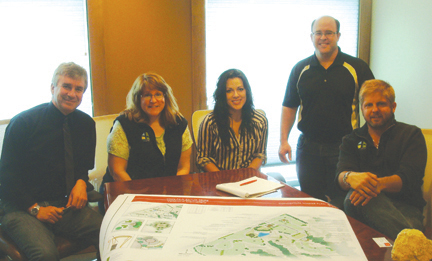
The Rapid City-based FourFront Design Inc. team is helping the Oglala Sioux Tribe build a new veterans cemetery. Company associates include, from left, Curt Huus, Kim Schmidt, Amanda Williams, Shane Matt and Eirik Heikes.
PINE RIDGE, SOUTH DAKOTA –– The Oglala Sioux Tribe soon will have its own place to memorialize war heroes and bring military family members home to rest with a new $6 million tribal veterans cemetery, project representative Jackie Big Crow said on May 3. The Oglala Sioux Tribe Veterans Cemetery will be located on the Pine Ridge Reservation, five miles east of Kyle, alongside the Big Foot Trail off Bureau of Indian Affairs Highway 2 to Wanblee. “I feel that pride in having our own cemetery is going to mean a lot,” Big Crow told Native Sun News. “It’s to honor our veterans, and once it’s built, I think we will have a lot of requests to be brought back,” she added. Architectural drawings are slated for completion May 16, followed by construction bidding in June and groundbreaking in July, according to Eirik Heikes, the project’s manager at FourFront Designs Inc. in Rapid City. “It’s expected there will be not quite a year’s worth of construction, and hopefully, it will be operating in the spring or summer of 2013,” Heikes said. A team of 15 people at FourFront Designs has collaborated on the master planning with the tribe’s project manager, Rodney Clark, and the National Cemetery Association’s landscape architect, Howard Orr, who was assigned as an engineering project manager by the National Cemetery Administration. The new burial grounds will facilitate the practice of Lakota ceremonial rites that tribal members complain are restricted by rules at other veterans cemeteries. “This will allow people on the reservation to have more flexibility for their culture,” FourFront Design’s project engineer, Shane Matt, said. The design contemplates Lakota traditions such as horseback escorts delivering the deceased to their destinations and the ritual of families taking food to the interment site to feed the dead, Big Crow said. Burial scaffolds, anchored with local granite from Crazy Horse Memorial at the tribe’s request, will allow for the observance of formal blessings prior to interment, Heikes noted. Architects’ drawings depict a committal shelter designed in the likeness of a medicine wheel and entrances to the cemetery as well as its buildings, all located on the east side in keeping with custom. “We’ve had an enjoyable time blending the requirements of the Veterans Administration with the Oglala values,” Heikes said. “It’s been an honorable translation.” A flag assembly area and an avenue of flags add decorum to the design. The tribe is planning to install plaques that commemorate late tribal military code talkers, such as Clarence Wolf Guts, according to Big Crow. Among advisers consulted in the design process were tribal members Elmer Mesteth and Joe Rosales. Just 18 acres of the 63-acre site will be dedicated to interment. The other three-fourths of the site is “a celebration of the native landscape,” Heikes said, noting it is a hilly acreage that will be preserved with its original terrain of big draws and coulees, ponderosa pines, ash trees, chokecherry bushes and sage. The eroded peaks of the Badlands and the grassy bluffs of Pine Ridge are in sight of the location. “It’s a beautiful site with a great view of the sunrise,” Heikes said. The distance to the new cemetery will be closer than most existing options for veterans’ families, Big Crow noted. “A lot of our tribal members are buried at Black Hills National Cemetery,” she said. That veterans cemetery is located more than 100 miles to the northwest, near Sturgis. Another area option for veteran family members’ interment is the Hot Springs National Cemetery, located more than 100 miles west of Kyle. The OST Veterans Cemetery is the second in the nation to be built by a tribe since the federal Department of Veterans Affairs opened its cemetery grants program to Indian reservations in 2006. Rosebud was the first tribe to build a veterans cemetery, receiving a $7 million grant for a new 74-acre burial ground last year. It has a committal shelter reminiscent of a tipi dwelling and road layout plan in the shape of a sacred turtle protector. OST has been toying with the grant application through three tribal administrations. Originally considering approval of a tribal contribution of $200,000, it eventually provided $600,000 to meet a requirement for 10 percent matching funds. Tribal government designated the trust land for the project and is responsible for operating it in accordance with National Cemetery Administration standards. The $6-million donation from the combinatory Veterans Administration National Cemetery and state and tribal Cemetery Grants Program is part of an overall project conceived to complement the 131 national cemeteries across the country. VA has awarded grants totaling more than $438 million under the program. The OST project is one of 104 state and tribal cemetery development grant applications on the federal government’s 2012 priority list, for total funding of $277 million. (Contact Talli Nauman at talli.nauman@gmail.com)
Join the Conversation